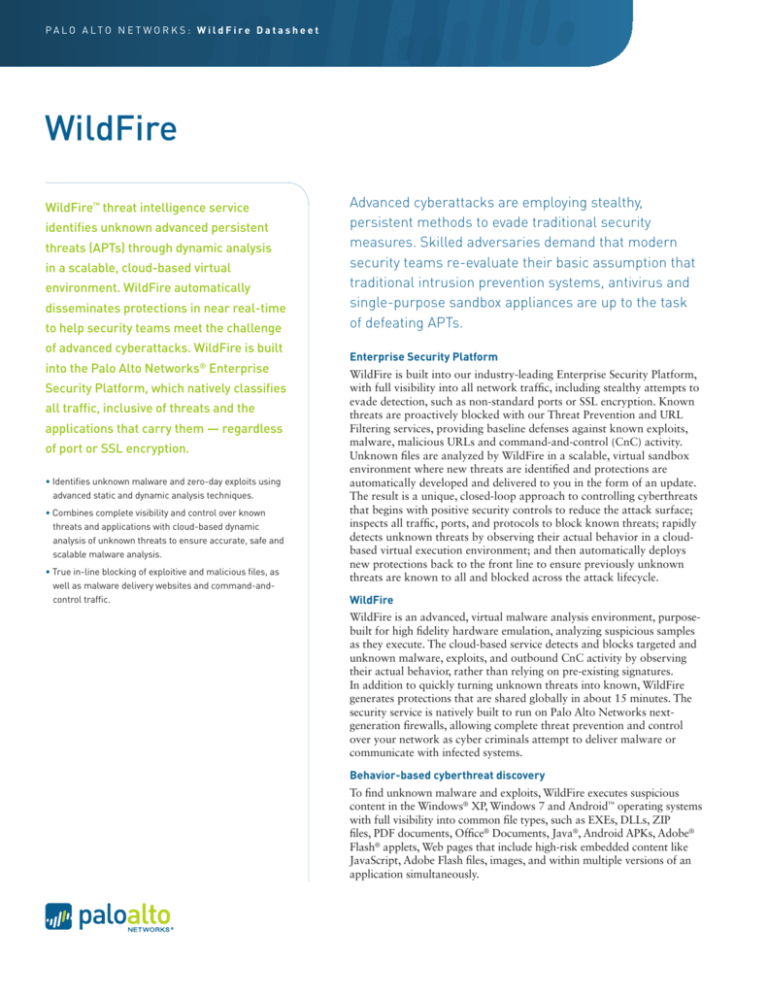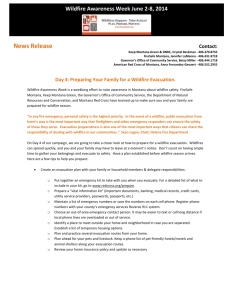
PA L O A LT O N E T W O R K S : W i l d F i r e D a t a s h e e t
WildFire
WildFire™ threat intelligence service
identifies unknown advanced persistent
threats (APTs) through dynamic analysis
in a scalable, cloud-based virtual
environment. WildFire automatically
disseminates protections in near real-time
to help security teams meet the challenge
of advanced cyberattacks. WildFire is built
into the Palo Alto Networks® Enterprise
Security Platform, which natively classifies
all traffic, inclusive of threats and the
applications that carry them — regardless
of port or SSL encryption.
• Identifies unknown malware and zero-day exploits using
advanced static and dynamic analysis techniques. • Combines complete visibility and control over known
threats and applications with cloud-based dynamic
analysis of unknown threats to ensure accurate, safe and
scalable malware analysis. • True in-line blocking of exploitive and malicious files, as
well as malware delivery websites and command-andcontrol traffic.
Advanced cyberattacks are employing stealthy,
persistent methods to evade traditional security
measures. Skilled adversaries demand that modern
security teams re-evaluate their basic assumption that
traditional intrusion prevention systems, antivirus and
single-purpose sandbox appliances are up to the task
of defeating APTs.
Enterprise Security Platform
WildFire is built into our industry-leading Enterprise Security Platform,
with full visibility into all network traffic, including stealthy attempts to
evade detection, such as non-standard ports or SSL encryption. Known
threats are proactively blocked with our Threat Prevention and URL
Filtering services, providing baseline defenses against known exploits,
malware, malicious URLs and command-and-control (CnC) activity.
Unknown files are analyzed by WildFire in a scalable, virtual sandbox
environment where new threats are identified and protections are
automatically developed and delivered to you in the form of an update.
The result is a unique, closed-loop approach to controlling cyberthreats
that begins with positive security controls to reduce the attack surface;
inspects all traffic, ports, and protocols to block known threats; rapidly
detects unknown threats by observing their actual behavior in a cloudbased virtual execution environment; and then automatically deploys
new protections back to the front line to ensure previously unknown
threats are known to all and blocked across the attack lifecycle.
WildFire
WildFire is an advanced, virtual malware analysis environment, purposebuilt for high fidelity hardware emulation, analyzing suspicious samples
as they execute. The cloud-based service detects and blocks targeted and
unknown malware, exploits, and outbound CnC activity
by observing
their actual behavior, rather than relying on pre-existing signatures.
In addition to quickly turning unknown threats into known, WildFire
generates protections that are shared globally in about 15 minutes. The
security service is natively built to run on Palo Alto Networks nextgeneration firewalls, allowing complete threat prevention and control
over your network as cyber criminals attempt to deliver malware or
communicate with infected systems.
Behavior-based cyberthreat discovery
To find unknown malware and exploits, WildFire executes suspicious
content in the Windows® XP, Windows 7 and Android™ operating systems
with full visibility into common file types, such as EXEs, DLLs, ZIP
files, PDF documents, Office® Documents, Java®, Android APKs, Adobe®
Flash® applets, Web pages that include high-risk embedded content like
JavaScript, Adobe Flash files, images, and within multiple versions of an
application simultaneously.
PA L O A LT O N E T W O R K S : W i l d F i r e D a t a s h e e t
WildFire identifies more than 250 potentially malicious behaviors
to identify the true nature of malicious files based on their
actions, including:
• Changes made to host: observes all processes for modifications to the host, including file and registry activity, code
injection, heap spray (exploit) detection, the addition of
auto-run programs, mutexes, Windows services, and other
suspicious activities.
• Suspicious network traffic: analysis of all network a­ ctivity
produced by the suspicious file, including backdoor
creation, downloading of next-stage malware, visiting
­low-reputation domains, network reconnaissance, and
much more.
• Anti-analysis detection: monitors for techniques used by
advanced malware to avoid VM-based analysis, such as
debugger detection, hypervisor detection, code injection
into trusted processes, disabling of host-based security
features, and more.
Extending the next-generation firewall platform that natively
classifies all traffic across hundreds of applications, WildFire
uniquely applies this behavioral analysis, regardless of ports
Exfiltration
of sensitive data
or encryption, including full visibility into Web traffic, email
protocols (i.e. SMTP, IMAP, POP) and FTP.
Cloud-based detection architecture
To support dynamic malware analysis across the network
at scale, WildFire is built on a cloud-based architecture that
can be leveraged by your existing Palo Alto Networks nextgeneration firewall, with no additional hardware. Where
regulatory or privacy requirements prevent the use of public
cloud infrastructure, a private cloud solution can be built on
premise using the WF-500 appliance.
In addition to either public or private cloud deployments,
leveraging both within the same environment is also an
option. Our hybrid cloud capabilities allow users more
file analysis flexibility, as they are able to define which file
types are sent to the WildFire public cloud versus the onpremise WF-500, or private cloud. The WildFire hybrid cloud
capability enables customers to alleviate privacy or regulatory
concerns, by utilizing both the WF-500 for file types
containing sensitive data, and benefit from the comprehensive
analysis and global threat intelligence services of the WildFire
public cloud for all others.
In each case, WildFire provides the same best-in-class visibility
and simple, cost-effective deployment.
Command
and control
DATA
Adds to threat signature
research database
Download
of additional
malware
WildFire Cloud
Observes and detects 130+ malicious
behaviors to identify malware and exploits
(available as a hosted or local cloud)
=
PATTERN DB
FILE TRANSFER DECODERS
SINGLE PASS PATTERN MATCH
REPORT & ENFORCE POLICY
How WildFire Works: WildFire provides a logical combination of next-generation firewall hardware and scalable cloud-based
malware analysis.
PAGE 2
PA L O A LT O N E T W O R K S : W i l d F i r e D a t a s h e e t
Threat prevention with global intelligence sharing
Maintaining the privacy of your files
When an unknown threat is discovered, WildFire automatically
generates protections to block it across the attack lifecycle,
sharing these updates with all subscribers across the globe in
as little as 15 minutes. These quick updates are able to stop
rapidly spreading malware, as well as identify and block the
proliferation of all future variants without any additional
action or analysis. Palo Alto Networks customers’ global
intelligence sharing helps put all of us one step closer to
stopping cyberattackers.
WildFire leverages a public cloud environment, managed directly
by Palo Alto Networks. All suspicious files are securely transferred
between the firewall and the WildFire data center over encrypted
connections, signed on both sides by Palo Alto Networks. Any files
that are found to be benign are destroyed, while malware files are
archived for further analysis.
In conjunction with protection from malicious and exploitive
files, WildFire looks deeply into malicious outbound
communication, disrupting command-and-control activity with
anti-CnC signatures and DNS-based callback signatures. The
information is also fed into PAN-DB, where newly discovered
malicious URLs are automatically blocked. This correlation of
data and in-line protection are key to identifying and blocking
ongoing intrusions as well as future attacks on a network.
Integrated logging, reporting and forensics
WildFire users receive integrated logs, analysis, and visibility
into WildFire events in Panorama management interface, or
the WildFire portal, enabling teams to quickly investigate and
correlate events observed in their networks. This allows security
staff to quickly locate the data needed for timely investigations
and incident response. Host-based and network-based indicators
of compromise become actionable through log analysis and
custom signatures.
To aid security and IR staff in discovering infected hosts,
WildFire also provides:
•Detailed analysis of every malicious file sent to WildFire
across multiple operating system environments and
application versions, including both host-based and
network-based activity. •“Grayware” verdicts for programs like adware or trackware
that do not pose a direct security threat, but display otherwise
suspicious behavior and can affect network performance,
allowing for more accurate incident prioritization, granular
content visibility and control.
•Session data associated with the delivery of the malicious
file, including source, destination, application, User-ID™,
URL, etc. •Access to the original malware sample for reverse engineering
and full PCAPs of dynamic analysis sessions. • Native integration with Traps™ Advanced Endpoint
­Protection to perform hash checks and receive unknown
EXE files for further analysis.
•An open API for integration with best-in-class SIEM tools,
such as the Palo Alto Networks application for Splunk®.
This analysis provides a wealth of indicators of compromise
(IOCs) that can be applied across the APT attack lifecycle.
• Access to the actionable intelligence and global context
provided by Palo Alto Networks new AutoFocus™ service.
PAGE 3
WildFire requirements:
•Use of WildFire requires PAN-OS® 4.1+
•Java, Office, APK, and multi-version PDF analysis requires
PAN-OS 6.0+
•Adobe Flash and Web page analysis requires PAN-OS 6.1+
•Grayware verdicts and hybrid cloud capabilities require
PAN-OS 7.0+
Licensing information:
Basic WildFire functionality is available as a standard feature
on all platforms running PAN-OS 4.1 or greater.
•Windows® XP and Windows 7 analysis images.
•EXE and DLL file types, including compressed (zip) and
encrypted (SSL) content.
•Automatically submit suspicious files to WildFire.
•Automatic protections are delivered with regular Threat
Prevention content updates (threat prevention license is
required) every 24 hours.
The WildFire subscription adds near real-time protection from
advanced threats, including these additional features:
•Automatic WildFire signature updates every 15 minutes for
all new malware detected anywhere in the world.
•Enhanced file type support, including: PE files (EXE, DLL,
and others), all Microsoft® Office® file types, Portable
Document Format (PDF) files, Java® applets (JAR and
CLASS), Android® application packages (APK), Adobe®
Flash® applets (SWF and SWC), and Web pages.
•WF-500 support.
•WildFire API for programmatic submission of up to 1,000
samples per day and up to 10,000 report and verdict queries
per day.
PA L O A LT O N E T W O R K S : W i l d F i r e D a t a s h e e t
WF-500
The WF-500 is an optional hardware appliance to support customers who choose to deploy WildFire as a private cloud for additional
data privacy. The WF-500 is sized to accommodate most mid-range to large-scale networks, with the option of deploying additional
appliances as traffic volumes increase or for networks that require geographic distribution.
WF-500 Specifications
MAX BTU/HR
PROCESSOR
• Dual 6-Core Intel Processor with Hyper-Threading
• 1,300 BTU/hr
INPUT VOLTAGE (INPUT FREQUENCY)
MEMORY
• 100-240 VAC (50-60 Hz)
• 128 GB RAM
MAX CURRENT CONSUMPTION
SYSTEM DISK
• 3.2A@120 VAC
• 120 GB SSD
SAFETY
• UL, CUL, CB
Hardware Specifications
EMI
I/O
• FCC Class A, CE Class A, VCCI Class A
• 4x10/100/1,000
ENVIRONMENT
• DB9 Console serial port, USB
• Operating temperature: 32° to 95° F, 5° to 35° C
STORAGE CAPACITY
• 2 TB RAID1: 4 x 1TB RAID Certified HDD for 2 TB of RAID Storage
• Non-operating temperature: -4° to 158° F, -40° to 65° C
POWER SUPPLY
• Dual 920 W power supplies in hot swap redundant configuration
MAX POWER CONSUMPTION
• 390 watts
RACK MOUNTABLE (DIMENSIONS)
• 2U, 19” standard rack (3.5” H x 21” D x 17.5” W)
To view additional information on the WF-500 security features and associated capacities, please visit:
http://www.paloaltonetworks.com/products/platforms/wildfire/wf-500/overview.html.
4401 Great America Parkway
Santa Clara, CA 95054
Main:+1.408.753.4000
Sales:
+1.866.320.4788 Support:+1.866.898.9087
www.paloaltonetworks.com
Copyright ©2015, Palo Alto Networks, Inc. All rights reserved. Palo Alto Networks,
the Palo Alto Networks Logo, PAN-OS, App-ID and Panorama are trademarks of
Palo Alto Networks, Inc. All specifications are subject to change without notice.
Palo Alto Networks assumes no responsibility for any inaccuracies in this document
or for any obligation to update information in this document. Palo Alto Networks
reserves the right to change, modify, transfer, or otherwise revise this publication
without notice. PAN_DS_WF_062315





